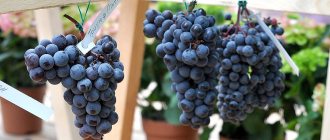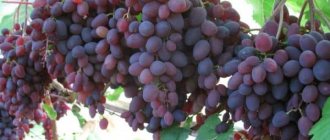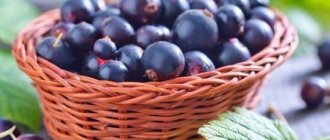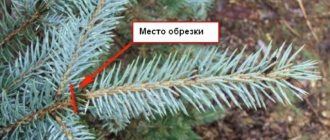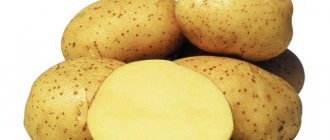Description of Catalonia grapes
Fruiting of the Catalonia variety begins in the first season after planting. The grapes growing in Ukraine, Belarus, and Moldova do not require any special care. For the cold regions of the North-West, Moscow region, and the Baltic states, this variety is not the most suitable; it will have to be carefully covered in anticipation of winter.
The grape bush of this variety has a powerful structure; massive clusters weighing from 600 g to 1 kg are easily held on the vine. The bushes are generously strewn with massive conical clusters.
Depending on the region of growth, the variety can be classified as either early-ripening or mid-ripening. In warm regions, the berries begin to ripen by the end of July; in mid-latitudes, you can enjoy their taste no earlier than the last ten days of August.
Useful video
Visual overview of the Catalonia grapes in this video:
This is how, using simple tips and having an idea of what to do and what not to do, you can achieve colossal results. After the first year of seedlings of Catalonia grapes, you will taste its unusually tasty and pleasant berries, to the envy of all your neighbors.
So don’t put off searching for seedlings for too long, and next year you will be able to treat your family and friends with this delicacy.
Happy landing!
Description of the bush
The bushes are vigorous, spreading, and resistant to stress. The shoots growing together reinforce each other. The leaves are medium sized, dark green. The veins do not differ in color, but clearly stand out on the leaf plate.
The seedling takes root quickly in fertile soils. The plant is highly adaptable to climatic conditions. Immediately after planting, the plant begins to take root intensively, and simultaneously with this stage, the formation of the vine occurs.
The first harvest consists mainly of bunches not exceeding 500-600 g. Proper care of the plant will increase the yield by increasing the weight of each berry (from 12 to 18 g).
Main characteristics
Catalonia is not highly resistant to frost. The maximum cold snap that the bush can withstand during winter without consequences is -23 °C. Resistance to fungal diseases and insect pests. Fruiting is abundant, annual.
Sweet and juicy berry
The berries of the Catalonia grape variety attract wasps and birds with their aroma and juiciness. It is extremely difficult for wasps to damage the thick skin, but the beaks of birds can seriously damage the crop. Large berries, growing in heavy clusters, are more often used for making wine than for consumption raw. The tasting assessment of the taste of Catalonia is 8.9 points out of 10 possible.
The sweet taste of the pulp is mixed with the tart aroma of the skin, which gives an astringent aftertaste. This combination of pulp and skin flavors is typical for grape varieties grown for wine production.
Immunity from diseases and pests
Catalan grape bushes are resistant to fungal pathogens - mildew, oidium, gray rot. Most insect pests do not like this grapevine variety. The tart aroma of the skin of the berries repels leaf rollers and phylloxera.
See also
How to protect and get rid of wasps on grapes during their ripening, what to do to fight themRead
Diseases and pests
Since Catalonia is a hybrid grape, its creator made a lot of efforts to ensure that the variety was resistant to the effects of many diseases and pests characteristic of these plants.
Find out why grapes on the bush wither.
Thus, an adult bush exhibits resistance to diseases such as:
- mildew (downy mildew);
- oidium (powdery mildew or ashtray);
- gray rot.
However, for good growth and yield, it is necessary to create optimal growing conditions, since planting young Catalan vines in swampy areas can lead to the appearance of gray rot, which must be controlled with fungicides.
When growing this variety, you need to know that it is susceptible to the following diseases:
- Anthracnose (bird's eye). Its causative agent is a mold fungus of the genus Fusaria. The disease is characterized by wilting of leaves, bunches and shoots, and possible death of the bush. The disease can be recognized by the appearance of uneven, dry spots with a red coating, similar in appearance to ulcers, on the body of the plant. For prevention and elimination, copper preparations and fungicides (Ridomil, Skor, Acrobat) are used.
- Chlorosis . This disease is manifested by yellowing of the leaves, slow growth and development of the vine, and death of the ovaries as a result of impaired ability to produce chlorophyll. To correct this condition, the following measures are used: replacing alkali with potassium sulfate and ferrous sulfate in fertilizers, improving drainage to avoid stagnation of water in the soil.
- Bacterial cancer . This is a destructive disease for the plant, which threatens the spread of bacteria to garden tools and planting material. The diseased plant is uprooted and the soil is carefully inspected to remove all roots from it. After this, it is necessary to disinfect the soil and garden tools.
The variety is not susceptible to insects, wasps will not disturb the bushes, since the grapes have a dense skin that reliably protects it. A dangerous pest for Catalonia is the felt mite, which feeds on plant sap and lives on the underside of the leaf. It secretes salivary fluid, which transforms into a fluffy coating. To combat it, acaricides (Apollo, Envidor) and sulfur preparations are used.
Read more about why grapes dry out and how to deal with it.
The newly created Catalonia hybrid has already become a favorite among many winegrowers due to its taste, very early ripening, resistance to many diseases and the ability to easily transport the crop. These main advantages of the variety qualitatively distinguish it from others and provide a good prospect for development and popularity.
What is special and how does the variety differ from others?
The peculiarity of the variety lies in its tendency to fasciation - the fusion of stems. This cannot be considered a disadvantage, because the vineyard shoots have to withstand a significant load.
Bunches of grapes ripen simultaneously and evenly, withstand a long shelf life without loss of presentation and taste. When mature clusters are left on the vine, the berries also do not wrinkle and do not lose their taste. The berries of the Catalonia grape variety are not prone to peas.
The plant develops poorly in soil with high acidity, cannot tolerate waterlogging, and is susceptible to chlorosis and mold. During severe frosts, the roots freeze, which affects the health of the bush and the quality of the harvest.
Botanical certificate
Catalonia is a unique hybrid variety with early ripening in the south and later in the northern regions. Red-violet variety, table variety (suitable for fresh consumption). The grapes are considered the best in terms of yield and survival rate of seedlings.
Description of the bush
The Catalonia bush is strong and tall with a strong root system. Each shoot can produce 3 bunches of grapes. But you need to control the overload by trimming the brushes and vines so that the plant does not break.
Catalonia adapts well to conditions, takes root and strengthens reliably. In the first year, grape clusters do not weigh more than 500 g; from the second year, you need to control the number of eyes; the vine can withstand up to 40.
Pollinators and flowering
Catalonia flowers are bisexual, the variety is self-pollinating.
Ripening time and harvest
The Catalan harvest is harvested in mid-late June in the southern regions, and in early-mid September in the northern regions. The first year the bush will be pleased with only 2-3 bunches of grapes, in subsequent years the vine will be strewn with bunches, not a single shoot will be left without berries. Berries can be stored in a cellar for a long time without loss of taste and presentation.
Taste and calorie content of berries
The brush of Catalonia reaches 1-1.5 kg. The berries are sweet, oval-oblong, similar in taste to cherries. The weight of 1 berry is about 17-20 g, length up to 4 cm or more. It turns purple-red during ripening. The pulp is juicy, the skin is dense, but unnoticeable and eatable. 100 g of grape fruit contains about 60 kcal.
Where are the berries used?
Aromatic and tasty table wine, desserts, drinks and preparations for the winter are prepared from the Catalonia variety. Grapes are added to salads and other dishes and consumed fresh. It is dried to make raisins, which are then added to baked goods and compotes.
See also
Description of Velika grapes, cultivation and care tips
Read
Landing in the ground
Before planting grape seedlings in the ground, their roots must be soaked in water for a day. If the soil is not fertile, then a growth regulator can be added to the water. It promotes better rooting and shoot formation.
Preparing the landing site
The area for planting must be leveled, the roots of weeds and stones must be removed from it. When choosing a location, it is necessary to take into account that the seedlings must be exposed to the sun's rays and protected from the winds. Lean soil must be saturated with mineral fertilizers, acidic soil must be normalized with fluffed lime, or better yet, ash.
Choosing seedlings
The young seedling has brown shoots with a greenish tint. The gray or dark brown color of the bark indicates that the seedling is old. It is not suitable for planting; its adaptation to a new place will be long and painful.
Peeling and lumpiness on the bark are signs of disease. Damage to the bark and broken branches are the highest risk areas for fungal and bacterial damage. Such seedlings are also not suitable. There should be no damage to the rhizome of the plant.
Landing calendar
From mid to late October, it is necessary to plant the seedling in a previously prepared hole. The favorable days for planting change every year. What remains unchanged is that it is recommended to replant plants on a waxing moon, and not on a waning one. If grapes are classified as berry bushes, then the suitable days are 2, 3, 11, 12, 15, 16, 20, 21; if Catalonia, due to its high growth and the peculiarity of the fusion of shoots, is classified as fruit trees, then it should be planted on 11, 12, 15 , 16th, 20th, 21st, 25th, 26th. You cannot plan planting on the 8th, 9th, 10th, or 24th; it will be more difficult for the plant to adapt and enter the stage of painless rooting.
Sequence of steps during disembarkation
The planting hole is prepared in advance, approximately 10-14 days before planting. The recommended width and depth is 1 m. It is partially filled:
- 15-20 cm - drainage layer.
- Soil mixed with humus and mineral fertilizers necessary for autumn fertilizing (the exact list of mineral additives is specified in accordance with the characteristics of the soil in the area).
- The enriched soil is covered with soil selected from the hole.
- Humidification is carried out - 10 liters of water.
A day before planting, the root system of the seedling is soaked in water. Immediately before planting, the roots are treated with a weak solution of potassium permanganate. This will protect the roots from insect pests and worms:
- The treated seedling is placed in the middle of the hole on an earthen elevation.
- Its roots are carefully straightened.
- The hole is filled 2/3 with soil (in chernozem regions, simple, in non-chernozem regions, enriched with compost, humus, manure).
- Watering is carried out, which will somewhat compact the soil.
- The hole is filled to the top with soil.
- After the soil is compacted, the area is mulched.
See also
Description and characteristics of Viking grapes, pros and consRead
Gartering for fast-growing Catalonia grape shrubs is a mandatory step.
Growing and care
Proper care ensures the health of the bush and a quality harvest for the winegrower.
Bush pruning
When pruning in autumn and spring, old shoots are removed; they are distinguished from the rest by their gray, flaky bark. Pruning of vines, leaves, and shoots affected by disease or insects is carried out immediately after detection of the disease. Weak and thin shoots are also cut off; they only draw juice from strong shoots, which will affect the size of the bunches.
Watering
Systematic watering of Catalonia grapes during the vegetative stage of the plant is recommended in areas with a hot, dry climate. Catalonia will not withstand strong moisture; it can be affected by a putrefactive fungus. In cold regions, abundant watering is recommended for the plant at stages:
- bud breaking;
- flowering;
- formation of bunches - weight gain;
- before the onset of winter frosts.
Attention! No watering is carried out 4 weeks before the planned harvest. The more moisture the grapes receive during this period, the more acids and less sugars there will be in its juice.
Fertilizer
Before the flowering period and during the formation of ovaries, the soil at the roots is enriched with nitrogen-containing fertilizers. Mineral fertilizers are applied as needed, which depends on the soil in which the vineyard is planted.
How to protect against diseases and pests
Preventive measures:
- timely protection from frost;
- high-quality fertilizers;
- spraying with insecticides until the vegetative stage;
- removing fallen leaves and fruits from under the bush;
- regular replacement of mulch after winter and harvest;
- pruning affected and damaged shoots as they are detected.
It is easier to prevent a disease than to treat it, risking the harvest.
Berry ripening
Ripening of the Catalonia grape variety occurs simultaneously. In Ukraine, Belarus, Moldova, and the Krasnodar Territory, it falls on the horses of July, in central Russia on the horses of August - early September.
Fruiting dates
After planting, already in the first season, the bushes of Catalonia delight with a decent harvest. From the beginning of the growing season to harvest in different climatic zones, it takes from 90 to 110 days.
Preparatory work before winter
In a climate where winters are not particularly harsh, the thermometer does not fall below -23 °C, Catalonia grapes are not threatened by freezing of roots and shoots. Here it is enough to carry out high-quality mulching of the soil. Where there is a threat of frequent thaws, it is necessary to provide drainage and drainage of melt water from plants.
In cold regions, it is necessary to cover the vineyard with film, creating greenhouse wintering conditions for it, and with each snowfall, increase the snowdrift next to it. The thicker the layer of snow, the less the ground will freeze.
Diseases and the fight against them
The most common diseases in Catalonia:
- mildew - a fluffy gray coating from which the berries fall off and dry out;
- powdery mildew - white coating on berries and leaves;
- anthracnose - brown spots on leaves and trunks;
- white, gray and black rot - the berries dry out, fall off and become deformed;
- black spot - black spots and necrosis, from which the fruits acquire a dark purple color.
Copper-based preparations and systemic fungicides are used against mildew and powdery mildew. To combat rot and black spot, choose chemicals that are applied before flowering:
- Ridomil Gold MC;
- Topaz;
- Quadris;
- Strobe.
In the fight against anthracnose, it is recommended to spray the bushes with Switch or Calypso. For preventive purposes, the vine is treated with soda at all stages of development. To do this, mix 100 g. soda, 100 gr. soap and 20 l. water. Fitosporin or Baikal are used as chemicals.

